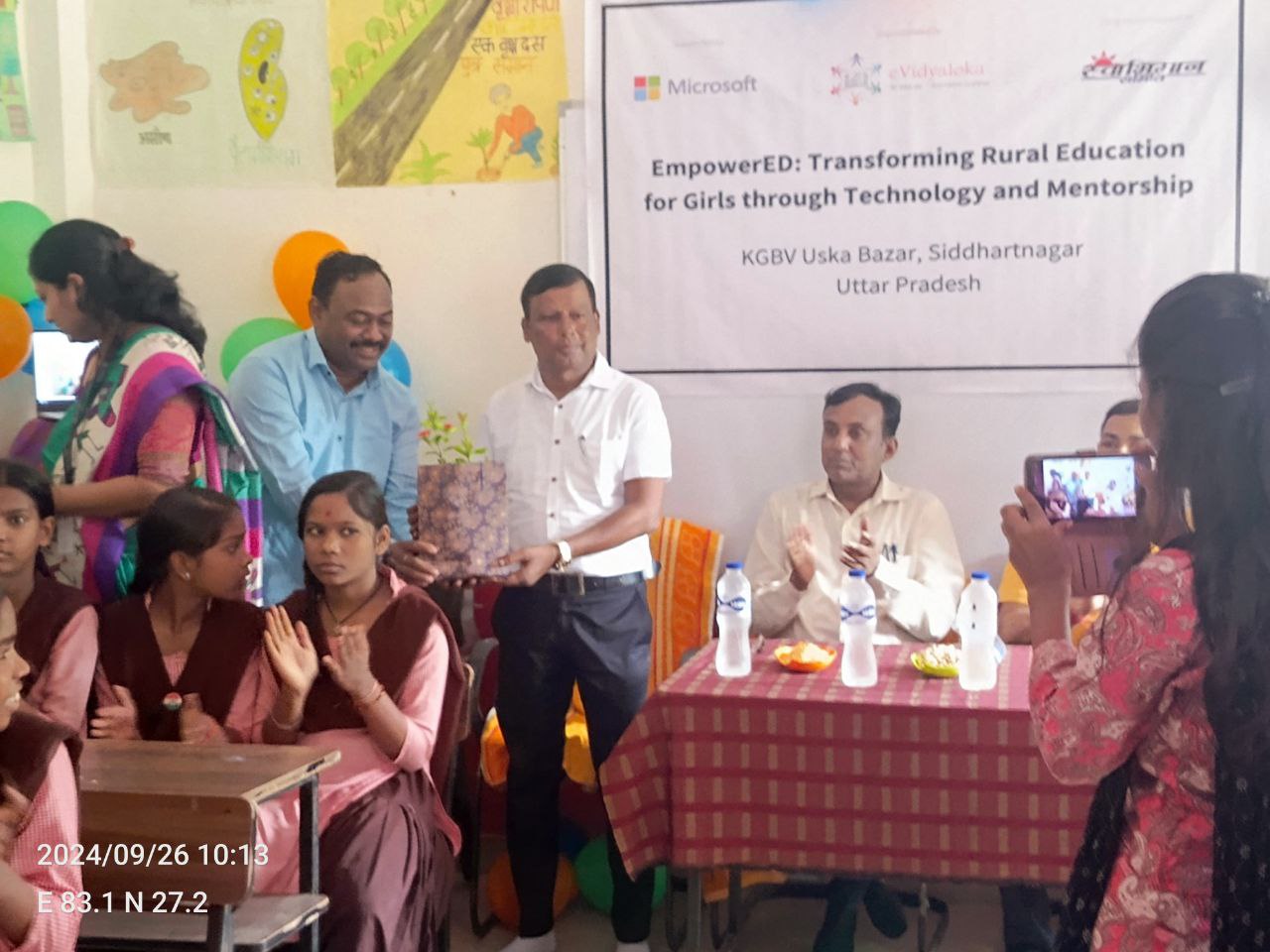Digital Classroom Program at KGBV ITWA
The Digital Classroom Program at KGBV ITWA, Siddharthnagar, implemented by Swabhiman Samiti, aimed to enhance digital literacy and promote STEM (Science, Technology, Engineering, and Mathematics) education among rural girl students. Running from December 2023 to March 2024, the program provided students with essential skills in digital technology and fostered interest in STEM fields through online classes, hands-on activities, and career awareness sessions. The program empowered 48 students, preparing them for academic and career opportunities in the digital world.
Key Highlights:
- Target Area: KGBV ITWA, Siddharthnagar, Uttar Pradesh
- Beneficiaries: 48 rural girl students in grades 6-8.
- Key Activities: Digital literacy training, STEM education, career awareness sessions,
SS










Project Details
- Project Name:
- Digital Classroom Program KGBV ITWA
- Thematic Area:
- Education
- Outcome:
- Increased student interest in STEM subjects, with students participating actively in STEM-related projects and discussions.
Funded By
- Funder Name:
- eVidyaloka
- Implementing Body:
- Swabhiman Samiti
Implemented By
Work Place
- Place of Work:
- Siddharthnagar District, Uttar Pradesh, India
- Year:
- 2023
Project Overview
The Digital Classroom Program at KGBV ITWA, Siddharthnagar, was implemented in collaboration with eVidyaloka and Swabhiman Samiti to enhance digital literacy and promote STEM (Science, Technology, Engineering, and Mathematics) education among rural girl students. Running from December 2023 to March 2024, the program aimed to empower students with essential digital skills and foster an interest in STEM fields. Through interactive online classes, co-scholastic activities, and career awareness sessions, the program sought to provide the students with the tools needed to succeed in an increasingly digital world.
Objectives
- Digital Literacy: Equip rural girl students with foundational digital skills to navigate the digital world effectively.
- STEM Education: Foster an interest and proficiency in STEM fields, helping students develop critical thinking and problem-solving abilities.
- Career Readiness: Prepare students for future educational and career opportunities in the digital age by broadening their academic and vocational knowledge.
- Promote Academic Excellence: Recognize and reward high-performing students to encourage continued academic success and commitment.
Background and Rationale
In many rural regions of India, access to quality education, particularly in digital literacy and STEM fields, remains limited. KGBV schools, like KGBV ITWA, face challenges such as lack of qualified teachers, outdated teaching methods, and insufficient infrastructure. The Digital Classroom Program was designed to address these challenges by integrating digital tools and resources into the classroom. This initiative aims to provide a scalable solution to digital education in rural India by leveraging volunteer teachers, digital platforms, and hands-on workshops. By doing so, it seeks to prepare students for the modern workforce and provide them with the skills necessary for academic and professional success.
Planned Outreach
The program was implemented in KGBV ITWA, Siddharthnagar, targeting 48 girl students across grades 6-8. The outreach aimed to deliver digital literacy training and introduce STEM education through interactive online lessons. The program also provided career awareness classes to expose students to potential career paths in the digital and STEM fields. The plan was to enhance students' academic engagement and encourage them to pursue further education in fields such as technology, science, and engineering.


Key Strategies
- Digital Infrastructure: Equipping the school with necessary digital tools such as computers, projectors, and internet connectivity to support online learning.
- Volunteer Teacher Engagement: Recruiting volunteer teachers to deliver live online classes, ensuring high-quality instruction in STEM subjects and digital literacy.
- Hands-on Learning: Organizing workshops and activities that allowed students to apply digital skills in real-world scenarios.
- Career Awareness: Providing students with exposure to various career paths through guest lectures, workshops, and one-on-one sessions with industry professionals.
- Regular Monitoring and Evaluation: Continuously monitoring student progress through assessments and feedback, making adjustments as needed to ensure the program's effectiveness.
Core Activities
- Digital Literacy Training: Basic computer operations, internet navigation, and essential software applications. Hands-on workshops and personalized learning assistance to ensure proficiency.
- STEM Education: Online sessions on science, technology, engineering, and mathematics, delivered through an interactive curriculum. Engagement through problem-solving activities, experiments, and STEM-related projects.
- Co-scholastic Activities: National Student Innovation Challenge to foster innovation. Career awareness sessions to inform students about potential career paths. Celebrations like Teacher’s Day and National Mathematics Day to engage students in extracurricular learning.
- Career Awareness Classes: Organized 9 sessions (out of planned 15) focusing on careers in digital technologies and STEM fields. Encouraged students to explore new academic and vocational opportunities.
- Scholarship Program: Offered scholarships based on academic performance to incentivize excellence and reward top-performing students.
Achievements and Outcomes
- Digital Literacy: 95% completion rate, with students demonstrating proficiency in basic computer skills, internet use, and essential software.
- STEM Engagement: Increased student interest in STEM subjects, with students participating actively in STEM-related projects and discussions.
- Co-scholastic Participation: Students engaged in innovation challenges and career workshops, boosting their confidence and career awareness.
- Academic Excellence: Two scholarships were awarded to top-performing students, incentivizing academic achievement.
- Student Attendance: 86% average attendance rate during the program.
- Learning Hours: A total of 350 child learning hours were completed, contributing to the program's impact on student learning.
Conclusion
The Digital Classroom Program at KGBV ITWA, implemented by Swabhiman Samiti, has successfully empowered rural girl students with essential digital skills and sparked an interest in STEM education. The program has made a positive impact, with high student engagement, improved digital literacy, and enhanced academic outcomes. By continuing to expand the program and incorporating more schools into the initiative, Swabhiman Samiti can help bridge the digital divide and ensure that rural students are prepared for the future. The program's success in fostering digital literacy, STEM proficiency, and career awareness is a significant step toward ensuring educational equity and providing students with the skills they need to thrive in the digital age.
